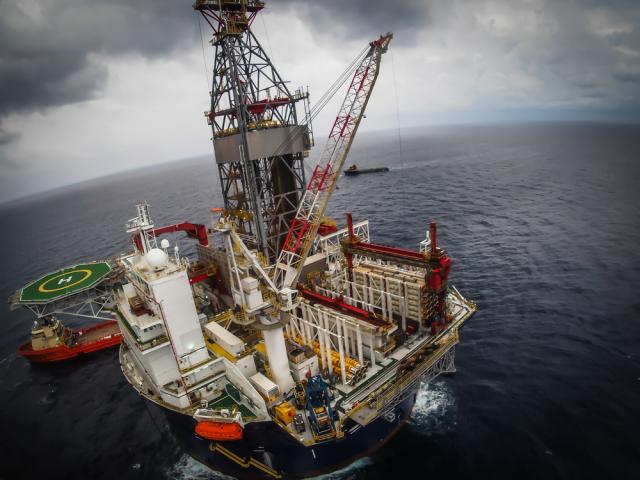
Combined, the 2019 startups are expected to add about 44,000 barrels per day (bbl/d) in production, while the 2020 projects will bring about 190,000 bbl/d. (Source: Shutterstock.com)
With eight new developments cranked up or preparing to do so this year and another four lined up for 2020, the U.S. Gulf of Mexico (GoM) is on track to hit more oil production records in federal waters, according to the U.S. Energy Information Administration (EIA).
The EIA forecasts oil production from new and existing fields in the GoM will rise to an average of 1.9 million barrels per day (MMbbl/d) this year and inch up to 2 MMbbl/d in 2020, besting the production record of 1.8 MMbbl/d set in 2018.
The higher production rates, based on the EIA’s Short-Term Energy Outlook, are seen “even after accounting for shut-ins related to Hurricane Barry in July 2019 and including forecasted adjustments for hurricane-related shut-ins for the remainder of 2019 and for 2020,” the EIA said in a report released Oct. 16.
The positive outlook comes as the offshore industry continues to bring down costs and improve breakevens by modifying designs, working closely with suppliers, taking phased development approaches and utilizing existing infrastructure.
Subsea wells tied back to production facilities already in place have been reducing not only costs but also start-up times in the GoM.
So far, this year Covington, La.-based LLOG Exploration LLC has started production at the deepwater Buckskin development in the Keathley Canyon area. As described by LLOG, the initial phase of development includes two wells and a 6-mile subsea tieback to the Lucius platform. Production for the first phase of the project, the company’s first in the Lower Tertiary trend, is about 30,000 bbl/d.
“Additional phases of development will be required to fully develop the field, which is estimated to contain nearly five billion barrels of oil in place,” LLOG said in June.
Earlier this year, LLOG COO Rick Fowler told Hart Energy that the field’s previous operator had a more than $2.2 billion budget for what was a four-well project at the time. “LLOG reduced the scope to two wells and was able to successfully execute the first phase of the project for less than $0.6 billion,” he said.
The company is also the operator of the two-well Stonefly development, which is expected to start up this year. Located in the Viosca Knoll area of the GoM, Stonefly is also subsea tieback—connected to the Talos Energy-owned Ram Powell platform.
Royal Dutch Shell also had two developments listed on the 2019 startup list, including Appomattox which marked first oil in May. The development, which includes the nearby Vicksburg deepwater field, is the industry’s first commercial discovery in the deepwater Norphlet Formation, according to Shell. Appomattox features 15 producing wells, five water injection wells, a subsea system with six drill centers, a semisubmersible and a production platform.
At the time of startup, production from Appomattox and Vicksburg was expected to peak at about 175,000 barrels of oil equivalent per day.
Other developments on the 2019 list are Hadrian North and Constellation, which both started production earlier this year; the Murphy Oil-operated Nearly Headless Nick, which was discovered by LLOG, and W&T Offshore’s Gladden Deep.
The latter, a single-well subsea tieback to the Medusa spar, is expected online in fourth-quarter 2019, according to W&T Offshore.
Developments scheduled for 2020 startups include Talos Energy’s Bulleit, BP’s Atlantis North, Murphy Oil’s Calliope and Fieldwood Energy’s Orlov, the EIA said, citing Rystad Energy.
Combined, the 2019 startups are expected to add about 44,000 bbl/d in production, while the 2020 projects will bring about 190,000 bbl/d.
Despite the growth, however, the percentage of U.S. crude oil production coming from the GoM is expected to fall to 15% in 2019 and 2020, down from 23% in 2011.
“Onshore production growth continues to outpace offshore production growth,” the EIA said, though shorter-cycle onshore shale plays are still more vulnerable to swings in oil prices which may in turn impact the pace of activity.
Recommended Reading
Pioneer Energy’s Tech Offers More Pad Throughput, Fewer Emissions
2025-01-14 - Pioneer Energy’s Emission Control Treater technology reduces emissions and can boost a well’s crude yield by 5% to10%, executives say.
Momentum AI’s Neural Networks Find the Signal in All That Drilling Noise
2025-02-11 - Oklahoma-based Momentum AI says its model helps drillers avoid fracture-driven interactions.
No Drivers Necessary: Atlas RoboTrucks Haul Proppant, Sans Humans
2025-03-04 - Atlas Energy Solutions and Kodiak Robotics have teamed up to put two autonomous trucks to work in the Permian Basin. Many more are on the way.
SLB’s Big Boost from Digital Offsets Flat Trends in Oil, E&P
2025-01-20 - SLB’s digital revenue grew 20% in 2024 as customers continue to adopt the company's digital products, artificial intelligence and cloud computing.
Then and Now: 4D Seismic Surveys Cut Costs, Increase Production
2025-03-16 - 4D seismic surveys allow operators to monitor changes in reservoirs over extended periods for more informed well placement decisions. Companies including SLB and MicroSeismic Inc. are already seeing the benefits of the tech.
Comments
Add new comment
This conversation is moderated according to Hart Energy community rules. Please read the rules before joining the discussion. If you’re experiencing any technical problems, please contact our customer care team.






